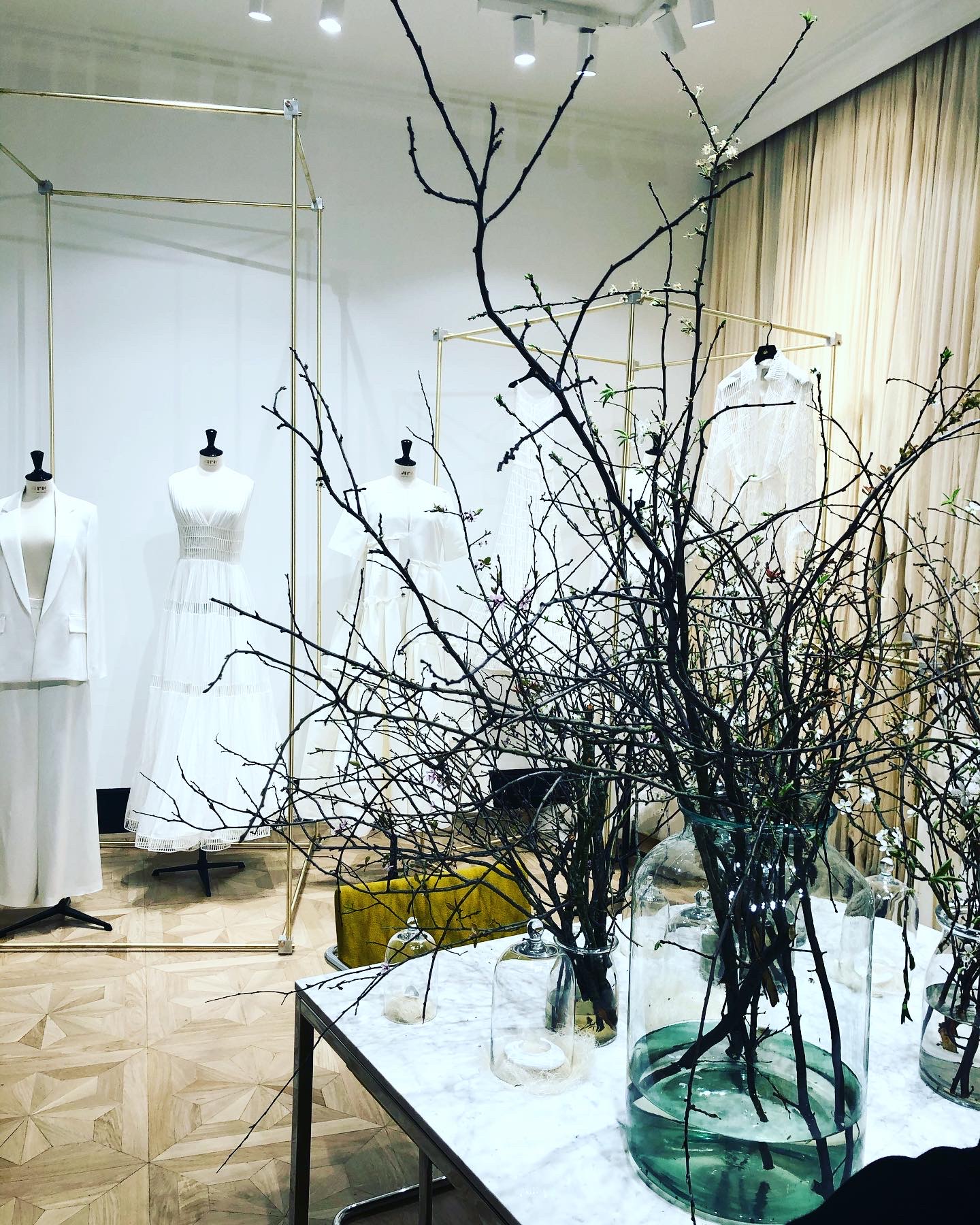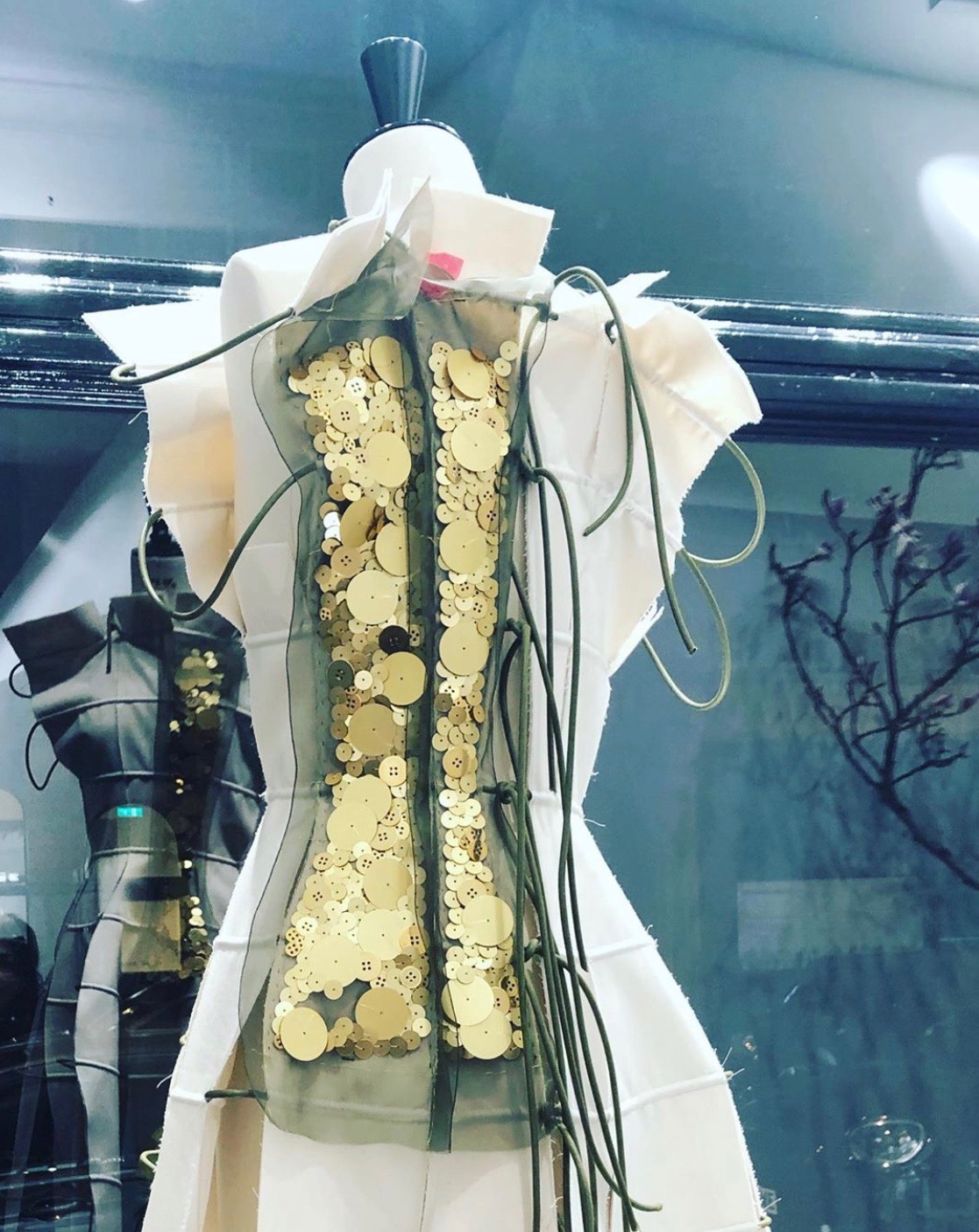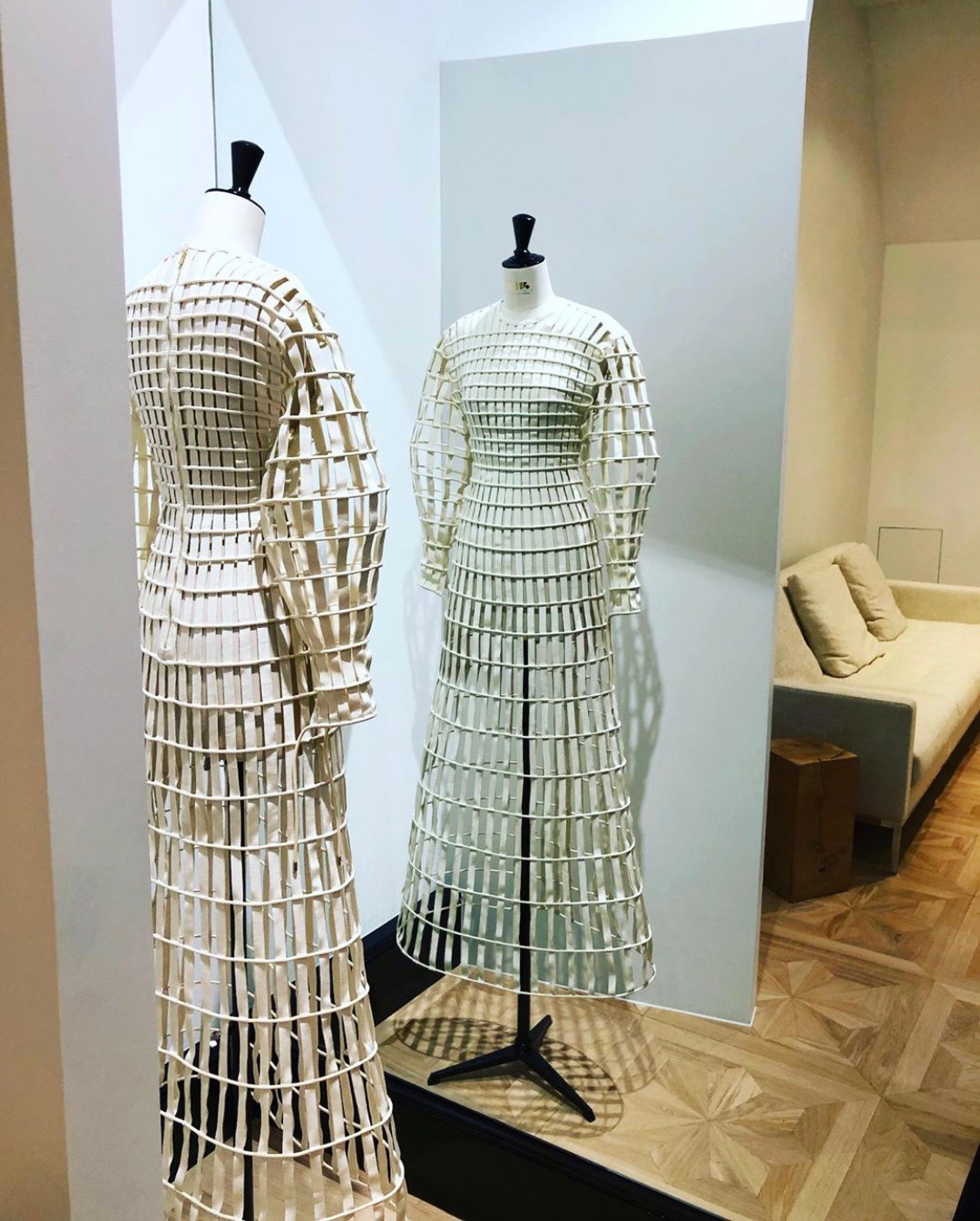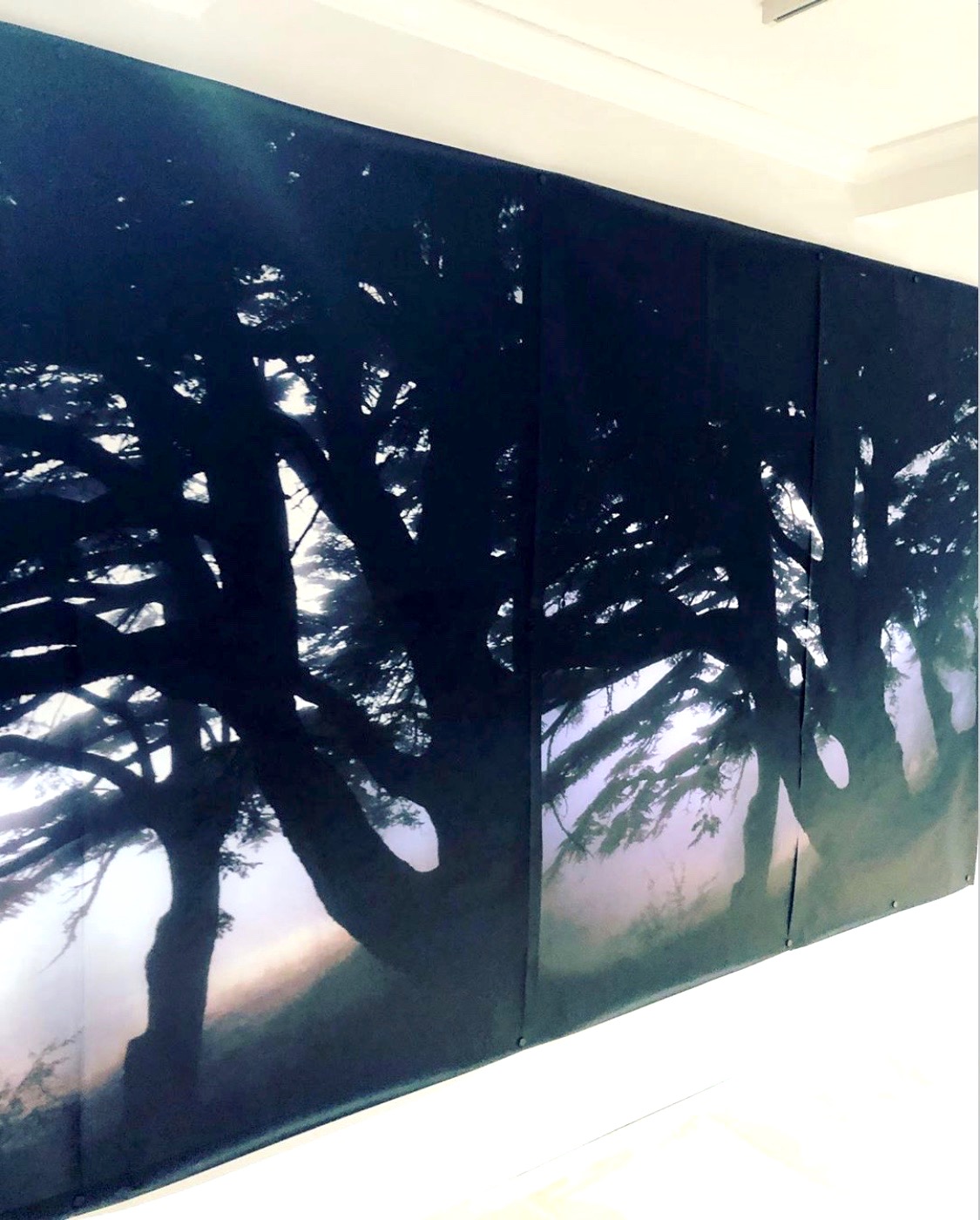Rabih Kayrouz on his Journey in Fashion,
the Craft of Creativity, Creating with Emotion,
Respecting the Procedure of Design, Being in the Now
and Starch Foundation

Rabih Kayrouz photographed by Sylvain Oger at his studio in Paris
Fashion is an important element of the creative industries, it is an essential part of any economy. It aslo plays an indispensable role in keeping a craft alive, with many intricate artisanal traditions and knowledge being brought forward. Fashion is also a great form of self-expression, a tool for voices to be heard and a key that can help us dream.
Fashion is an art.
At the new Maison Rabih Kayrouz store, art and fashion intertwine to bring out great craftmanship, attention to cut and structure. Delicate, intricate, crisp and modern fashion designs are displayed across the beautiful space. Also on display majestic art by artist Nadim Asfar where light shines through the Cedars of Lebanon in a panoramic vision of photography. Lebanon’s creativity is in full swing in London...
In light of Maison Rabih Kayrouz's new fashion boutique in London on Mount Street, we revisit below our interview with the designer....

When did you first want to become a fashion designer?
I was 11 years old, and I was asked at school what I wanted to do when I grew up. I answered fashion designer. It just came out of my mouth, very naturally. Actually, everything has happened that way in my life, through instinct.
What do you like most about fashion? Or what do you like most about clothes? Do you differentiate between both?
I differentiate between both. I prefer the clothes.
Yes, i am a fashion designer, but i am also a clothes creator. I love to create clothes. I have this obsession to create a wardrobe, a complete wardrobe full of objects, this is how I call my clothes. A piece of clothing is like an object, but worn by a body. What is important to me in regards to clothes or fashion is that it has to be something new and desirable. First, when I design, it has to come from the deepest place in my heart, and then I want my clothes to seduce.
It is a whole playful game of seduction between the fabric and myself, the body and myself and then, it is as if I am offering this to the client, the woman who is going to wear the garments.
So what words would best describe the Maison Rabih Kayouz woman?
I would say a certain mixture of strength and confidence. She is definitely powerful. She’s confident, so there is maybe a slight appearance of arrogance with her attitude. What makes her look beautiful and elegant is what resonates from her determination and confidence.
Maybe confidence can come through wearing certain clothes?
Clothes can help showcase it, but I am not adding anything to a woman. I am just helping through the clothes. Garments help you be who you are, but they don’t make you a different person. Actually, I hate clothes that make you look like somebody else, and I do not do that with my designs. A woman is already beautiful, but the way she wears clothes, will help her look more beautiful. The woman provides character, attitude, and then suddenly the dress compliments the woman, it is following her. The clothes will help her to look how she really wants to be. The vision and image she projects is a combination of the clothes she wears and her personality.
How would you define fashion?
Well, not all fashion is like that, there are a lot of designers who bring a certain shape, which has to be fit into. I am mostly the opposite. Nowadays, happily, every designer has his own vision, there’s not one aspect of fashion or a silhouette that one has to adhere to. And if you look around, what is fashion today? Instead of talking about fashion I would talk about modernity, contemporary, because we are living today, in the now, we have to follow what’s around us, and we get inspired of what is going on, socially, politically, artistically. Through the interesting mirror of our surroundings, is what makes design and fashion.
What are your inspirations?
For me it really is everything around me, everything I see, everything I hear, everything I smell, because I am not resistant to what surrounds me, I absorb what is going on. As designers, we cannot, if we are sincere, not have a reaction.
But our inspirations can create different types of reactions. We can either be inspired by the moment and the ongoings of life, or we can enclose ourselves in a bubble. Myself in Paris, I have created a bubble: in my space, in my life, in my studio. I have protected myself in this bubble which I have set up, however, at the same time, I have a knowledge and the vision of what is happening around me, I keep absorbing what surrounds me. My studio has become my sanctuary but I am able to dip in and out. That is how I stay in the moment, in the now, without getting lost in a far away past or in an inaccessible future. I like the moment we are in, the now.
What is your starting point when you design? Is it a silhouette, a colour, a fabric or does it vary?
It varies, however in general I usually start with the fabrics. This is my first choice. Once I choose the fabrics, for example be it light, heavy, or colourful, the character of the collection and the silhouette of the season develop.
At the same time, all the work I give to the fabric comes from the certain sentiment I have in mind each season for the women I am dressing. It is generally a similar woman who harbours in my mind, but each season through my designs generates a different style and attitude. This is my playful thing.
You mentioned modernity, how would you describe the modern women?
I noticed that the modern woman has nothing to prove to anyone. She has fought and maybe today is still fighting for a certain position, but I realised that most modern women are carving their own path, and because of that, her evolution is much stronger and fuelled with confidence. There are of course still issues that women are fighting for. Life is not a long tranquil river. Nowadays problems seem to come from everywhere. I am still totally chocked that in the 21st century we are defining people by their religion and their race and we forgot that a person is a person, a good person or not. Defining, and judging, happens not only towards women, but also towards the human race. Today, there is a lot to do and we have problems related towards humanity, which we need to look at.
Do you think Haute Couture or the style of couture still has relevance in today’s society?
We don't showcase in Haute Couture season, for now I am totally concentrated on Ready to Wear and the expansion of my brand as a Ready to Wear label. Despite that, like most brands, we have clients who order special garments, they want unique pieces and we also do special editions for private clients.
The industry provides many jobs and I think Haute Couture and specific couture like garments will be maintained, there is still demand and also the money for it in this world. However, I would say that the couture life has lost its aura, because in the 1950s, Ready to Wear did not exist. So couture today is not a lifestyle anymore, it is more like a knowhow, a research of excellence, but it is no longer a way of life, an obligation. Today in Ready to Wear, we have the quality and the emotion of couture, which is what I do in my designs. I want it to have the same quality and emotion as a garment designed for Haute Couture, yet with a Ready to Wear approach, remaining accessible on a hanger in the boutiques of the world.
What do you think of the procedure of having the collection available to purchase by consumers straight after the show?
I cannot say I am against that. At the end of the day the clothes are made to be sold. However, nor can I say, that I am for it. What is important to me as a designer, is to please keep my designer process protected, don’t ask me to create on a Monday and then deliver it on a Tuesday, it is impossible. I need my process because if that is respected, then I have time to create, to concentrate, to really give from the bottom of my heart what I want to do. If this is taken into consideration and logistically the production is prepared and ready for the delivery, then I don’t care when it is sold. But sometimes it is not doable, and there is a certain process to respect. There is a creative process that we have to honour.
You were decorated by the French government in Paris with the Chevalier des Arts et des Lettres. How do you feel about Paris, what inspires you about this city?
It is so magical, everything is inspiring, my place here in Paris, the knowhow and the professionalism of the people I work with is appealing and comforting. Design is only achievable, if you have the right manufacturing. This aspect pushes creativity, pushes us to be really giving and to be generous with the designs.
But also, the city in itself is so inspiring, walking around, it is a city that takes you in. I have always had this impression. When I came, about 26 years ago*, I was straightaway adopted by Paris and never felt alone or abandoned. This feeling I have, I share with a lot of people who arrive in the city and have felt the same thing. The other evening I was having dinner with an Italian supplier and he was saying that if he ever finds himself alone an afternoon in Paris, he is not sad. All of the sudden, I saw myself in other cities, which I have visited, bigger, perhaps more beautiful, and very inspiring, but where I have had moments of loneliness and isolation, something I have not sensed in Paris. Perhaps, it is the continuity in the city from one area to the other, you never cross a no man’s land. I can talk for hours on this city, which I am in love with.
Could you tell us about Starch Foundation?
In 2008, myself, and Tala Hajar had the idea for Starch Foundation in Lebanon. Funnily enough, by coincidence, founding it coincided with my arrival to Paris. It was important for me to create this foundation, because I noticed after a couple of years of working in Lebanon, that there were many talented couturiers, but there were few opportunities for contemporary designers, young designers with an adventurous spirit. Instead of questioning why, we thought let’s try to create a support system and off we went. We have a variety of young designers from all diversities and types of backgrounds. Any designer, any person who has a project can come and propose it to us. The project can appertain to fashion, design, architecture or any creative field. After a certain time, we choose the designers and help launch them for a year. It is a free platform for them to make a name for themselves and to expand their creativity. After that they can fly with their own wings.
What advice would you then give to the next generation of fashion designers?
I feel that today we have a mission as designers to bring back emotion into the work.
We have a good knowhow, we have good materials, and we can create beautiful elements. But more than beautiful, those pieces have to bring something forward, they have not only to tell a story but really bring to the product or the garment, the designer’s belief, an authenticity, honesty and sincerity. These aspects can come out through a designer’s work. When you are sincere, it comes from your gut, from your insides and that in turn shines onto the creation.
Today we are all stuck with those business plans, we want to be protected by business angels and business developments and so forth, but we forgot, that yes business is important we have to sustain ourselves, but, business cannot create, business will protect a creation. So the basis is the creation, it is the design, you have to bring something creative. For instance, I take a risk, create a story, and then I protect my idea. I would advice young designers to follow their gut, work hard and put emotion into their work. It takes time, but the key is to work with love.







Artwork by Nadim Asfar
All images taken at Maison Rabih Kayrouz on 24 Mount St, Mayfair, London W1K 3AH.
Rabih Kayrouz portrait courtesy of Maison Rabih Kayrouz.
Fashion designer Rabih Kayrouz is the founder of Maison Rabih Kayrouz with boutiques in Lebanon, Paris and London. Due to the Civil war in Lebanon, a 16 year old Kayrouz, left his home country to begin studying at L’École de La Chambre Syndicale de la Couture Pairsienne. Upon graduation, he trained at the Houses of Chanel and Christian Dior. Once Lebanon entered into a peace treaty, the designer returned to his home country, and started to develop his own collections. By 2009, he had established Maison Rabih Kayrouz and was then invited by the Chambre Syndicale de la Couture Parisienne to become a correspondent member. He is a co-founder of Starch Foundation, a non-profit organisation which helps young Lebanese designers launch and promote their own debut collections. In 2013, he was a finalist for the ANDAM prize. Rabik Kayrouz has been awarded France's Chevalier de la Legion d'Honneur and in July 2019, Maison Rabih Kayrouz celebrated its 20th anniversary.
*as of today it has been 30 years-question and answers first pulished in 2016.
